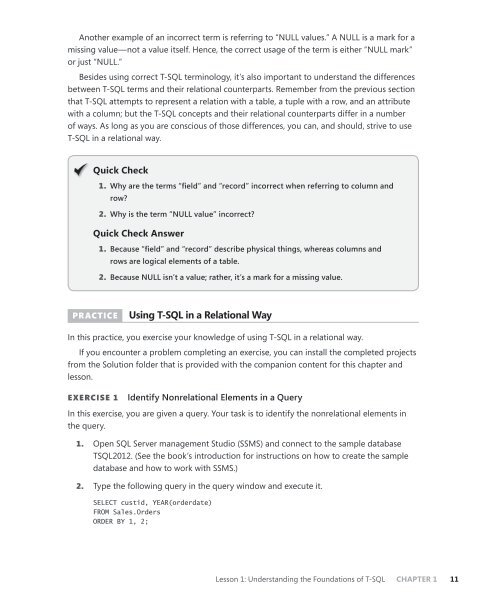Training Kit (Exam 70-461): Querying Microsoft ... - Cdn.oreilly.com
Training Kit (Exam 70-461): Querying Microsoft ... - Cdn.oreilly.com
Training Kit (Exam 70-461): Querying Microsoft ... - Cdn.oreilly.com
Create successful ePaper yourself
Turn your PDF publications into a flip-book with our unique Google optimized e-Paper software.
Another example of an incorrect term is referring to “NULL values.” A NULL is a mark for a<br />
missing value—not a value itself. Hence, the correct usage of the term is either “NULL mark”<br />
or just “NULL.”<br />
Besides using correct T-SQL terminology, it’s also important to understand the differences<br />
between T-SQL terms and their relational counterparts. Remember from the previous section<br />
that T-SQL attempts to represent a relation with a table, a tuple with a row, and an attribute<br />
with a column; but the T-SQL concepts and their relational counterparts differ in a number<br />
of ways. As long as you are conscious of those differences, you can, and should, strive to use<br />
T-SQL in a relational way.<br />
Quick Check<br />
1. Why are the terms “field” and “record” incorrect when referring to column and<br />
row?<br />
2. Why is the term “NULL value” incorrect?<br />
Quick Check Answer<br />
1. Because “field” and “record” describe physical things, whereas columns and<br />
rows are logical elements of a table.<br />
2. Because NULL isn’t a value; rather, it’s a mark for a missing value.<br />
Practice using t-sQL in a relational Way<br />
In this practice, you exercise your knowledge of using T-SQL in a relational way.<br />
If you encounter a problem <strong>com</strong>pleting an exercise, you can install the <strong>com</strong>pleted projects<br />
from the Solution folder that is provided with the <strong>com</strong>panion content for this chapter and<br />
lesson.<br />
exercise 1 Identify Nonrelational Elements in a Query<br />
In this exercise, you are given a query. Your task is to identify the nonrelational elements in<br />
the query.<br />
1. Open SQL Server management Studio (SSMS) and connect to the sample database<br />
TSQL2012. (See the book’s introduction for instructions on how to create the sample<br />
database and how to work with SSMS.)<br />
2. Type the following query in the query window and execute it.<br />
SELECT custid, YEAR(orderdate)<br />
FROM Sales.Orders<br />
ORDER BY 1, 2;<br />
Lesson 1: Understanding the Foundations of T-SQL chapter 1 11
















